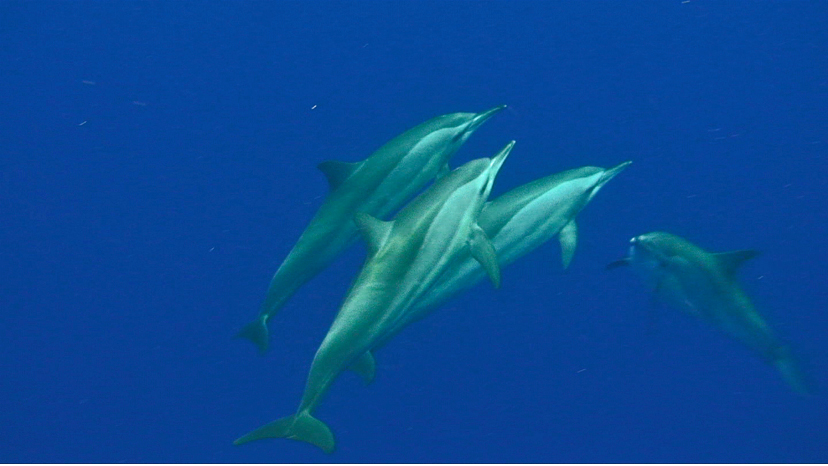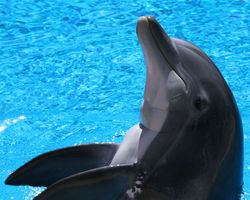Marine Life & Conservation
India Declares Dolphins “Non-Human Persons”; Dolphin Shows Banned

Amazing, overlooked news from several months ago out of India:
India’s Ministry of Environment and Forests has decided to forbid the keeping of captive dolphins for public entertainment anywhere in the country.
In a policy statement released Friday, the ministry advised state governments to reject any proposal to establish a dolphinarium “by any person / persons, organizations, government agencies, private or public enterprises that involves import, capture of cetacean species to establish for commercial entertainment, private or public exhibition and interaction purposes whatsoever.”
Why?
 “Whereas cetaceans in general are highly intelligent and sensitive, and various scientists who have researched dolphin behaviour have suggested that they exhibit unusually high intelligence compared to other animals means that dolphins should be seen as ‘non-human persons’, and as such should have their own specific rights and is morally unacceptable to keep them captive for entertainment purpose,” the ministry said.
“Whereas cetaceans in general are highly intelligent and sensitive, and various scientists who have researched dolphin behaviour have suggested that they exhibit unusually high intelligence compared to other animals means that dolphins should be seen as ‘non-human persons’, and as such should have their own specific rights and is morally unacceptable to keep them captive for entertainment purpose,” the ministry said.
I was surprised to read about this the other night, since it happened back in May and somehow escaped worldwide attention and the 24 hour media hoopla. The effort to re-categorize Cetaceans (dolphins, whales, porpoises) as non-human persons has been gathering steam since a meeting of the American Association for the Advancement of Science in 2011 where a group of philosophers, conservationists, and animal behaviourists attempted to gather wide support for a Declaration of Rights for Cetaceans from the scientific community.
The Declaration:
1. Every individual cetacean has the right to life.
2. No cetacean should be held in captivity or servitude; be subject to cruel treatment; or be removed from their natural environment.
3. All cetaceans have the right to freedom of movement and residence within their natural environment.
4. No cetacean is the property of any State, corporation, human group or individual.
5. Cetaceans have the right to the protection of their natural environment.
6. Cetaceans have the right not to be subject to the disruption of their cultures.
7. The rights, freedoms and norms set forth in this Declaration should be protected under international and domestic law.
And what does it mean to say an animal has “rights”?
Unlike positive rights, such as the ‘right’ to education or health care, the animal right is, at bottom, a right to be left alone. It does not call for government to tax us in order to provide animals with food, shelter, and veterinary care. It only requires us to stop killing them and making them suffer.
Seems reasonable enough. Considering dolphin intelligence has long been established, this declaration doesn’t seem to be a particularly radical move. They exhibit self-awareness, use tools, cooperate to solve tasks, and very recently it was found that they possibly communicate to each other using individual names. The major real world implications of declaring them non-human persons would be the closing of dolphin and orca shows at marine parks, setting them free from aquariums and zoos, and a prohibition against kills, such as the one documented in Academy Award winning movie The Cove.
Of course, the biggest implication is the whole idea of creating a new category of non-human persons. Do we stop at dolphins and whales? And, if not, where do we draw the line? Once we give rights to some animals how do we justify our continued exploitation of others?
By Jason Scott Hackman
Courtesy of www.dailykos.com
Blogs
Invitation from The Ocean Cleanup for San Francisco port call

6 years ago, The Ocean Cleanup set sail for the Great Pacific Garbage Patch with one goal: to develop the technology to be able to relegate the patch to the history books. On 6 September 2024, The Ocean Cleanup fleet returns to San Francisco bringing with it System 03 to announce the next phase of the cleanup of the Great Pacific Garbage Patch and to offer you a chance to view our cleanup system up-close and personal.
We look forward to seeing you there.
To confirm your presence, please RSVP to press@theoceancleanup.com
PROGRAM
Join The Ocean Cleanup as our two iconic ships and the extraction System 03 return to San Francisco, 6 years and over 100 extractions after we set sail, to create and validate the technology needed to rid the oceans of plastic.
Our founder and CEO, Boyan Slat, will announce the next steps for the cleanup of the Great Pacific Garbage Patch. Giving you a chance to view our cleanup system and the plastic extracted.
Hear important news on what’s next in the mission of The Ocean Cleanup as it seeks to make its mission of ridding the world’s oceans of plastic an achievable and realistic goal.
Interviews and vessel tours are available on request.
PRACTICALITIES
Date: September 6, 2024
Press conference: 12 pm (noon)
Location: The Exploratorium (Google Maps)
Pier 15 (Embarcadero at Green Street), San Francisco, CA
Parking: Visit The Exploratorium’s website for details.
RSVP: press@theoceancleanup.com
Video & photo material from several viewing spots around the bay
We look forward to seeing you there!
ABOUT THE OCEAN CLEANUP
The Ocean Cleanup is an international non-profit that develops and scales technologies to rid the world’s oceans of plastic. They aim to achieve this goal through a dual strategy: intercepting in rivers to stop the flow and cleaning up what has already accumulated in the ocean. For the latter, The Ocean Cleanup develops and deploys large-scale systems to efficiently concentrate the plastic for periodic removal. This plastic is tracked and traced to certify claims of origin when recycling it into new products. To curb the tide via rivers, The Ocean Cleanup has developed Interceptor™ Solutions to halt and extract riverine plastic before it reaches the ocean. As of June 2024, the non-profit has collected over 12 million kilograms (26.4 million pounds) of plastic from aquatic ecosystems around the world. Founded in 2013 by Boyan Slat, The Ocean Cleanup now employs a broadly multi-disciplined team of approximately 140. The foundation is headquartered in Rotterdam, the Netherlands, and opened its first regional office in Kuala Lumpur, Malaysia, in 2023.
Find out more about The Ocean Cleanup at www.theoceancleanup.com.
Marine Life & Conservation
SHARK MONTH ARRIVES AT ROYAL WILLIAM YARD, PLYMOUTH

A shark has been spotted approaching Royal William Yard in Plymouth, much to the surprise of swimmers, paddleboarders and onlookers.
With its distinctive dorsal fin cutting through the water, the sizeable shark swam along the coastline, before turning to head inland towards Firestone Arch at Royal William Yard. The appearance drew a crowd, who were captivated for more than an hour by the unusual sight – and it was all caught on video.
The shark is one of many expected sightings at Royal William Yard over the coming weeks… because today marks the start of Shark Month!
In reality, the ‘shark’ spotted along the Plymouth shoreline was actually a custom-made model, created by the team at Royal William Yard and sailed underwater by Caroline Robertson‑Brown from the Shark Trust, who donned scuba diving gear for the occasion.
The stunt took place to launch Shark Month in style and draw attention to the work of the leading international conservation charity, which is based in Britain’s Ocean City. Spectators were reassured that the water was safe and many entered into the spirit of the performance, swimming or sailing alongside the shark.
Shark Month will take place across Royal William Yard throughout July and will feature an extravaganza of art, entertainment and advocacy for everyone to enjoy. The packed programme of events starts with an art exhibition and ends with a trip on paddleboards with shark experts – with everything from a shark quiz to a Jaws screening in between.
Paul Cox, CEO of the Shark Trust, said: “There are often assumptions and misconceptions when it comes to sharks. This was certainly the case with the shark spotted at Royal William Yard! While the British coastline is home to many species of shark, this was not one of them. However, we’re thrilled it caught people’s attention, because seeing a shark is a special and memorable moment. That is precisely why we want to celebrate these incredible creatures, highlight the need for conservation, and ask for help to safeguard their future.”
For more information about Shark Month at Royal William Yard, visit the Shark Trust Website.
Images and video: Jay Stone
-

 Blogs2 months ago
Blogs2 months agoDiving With… Nico, Ocean Earth Travels, Indonesia
-

 News1 month ago
News1 month agoMurex Bangka Announce New Oceanfront Cottages & Beachfront Dining
-

 Blogs2 months ago
Blogs2 months agoA new idea in freediving from RAID
-

 Marine Life & Conservation1 month ago
Marine Life & Conservation1 month agoIceland issue millionaire whale hunter a licence to murder 128 vulnerable fin whales
-

 Marine Life & Conservation2 months ago
Marine Life & Conservation2 months agoThe Shark Trust Great Shark Snapshot is back
-

 News3 months ago
News3 months agoCharting New Waters; NovoScuba Goes Global with the Launch of their Revolutionary Dive Training Agency!
-

 Gear News1 month ago
Gear News1 month agoNew Suunto Ocean – a dive computer and GPS sports watch in one for adventures below and above the surface
-

 Marine Life & Conservation Blogs2 months ago
Marine Life & Conservation Blogs2 months agoBook Review: Plankton
















